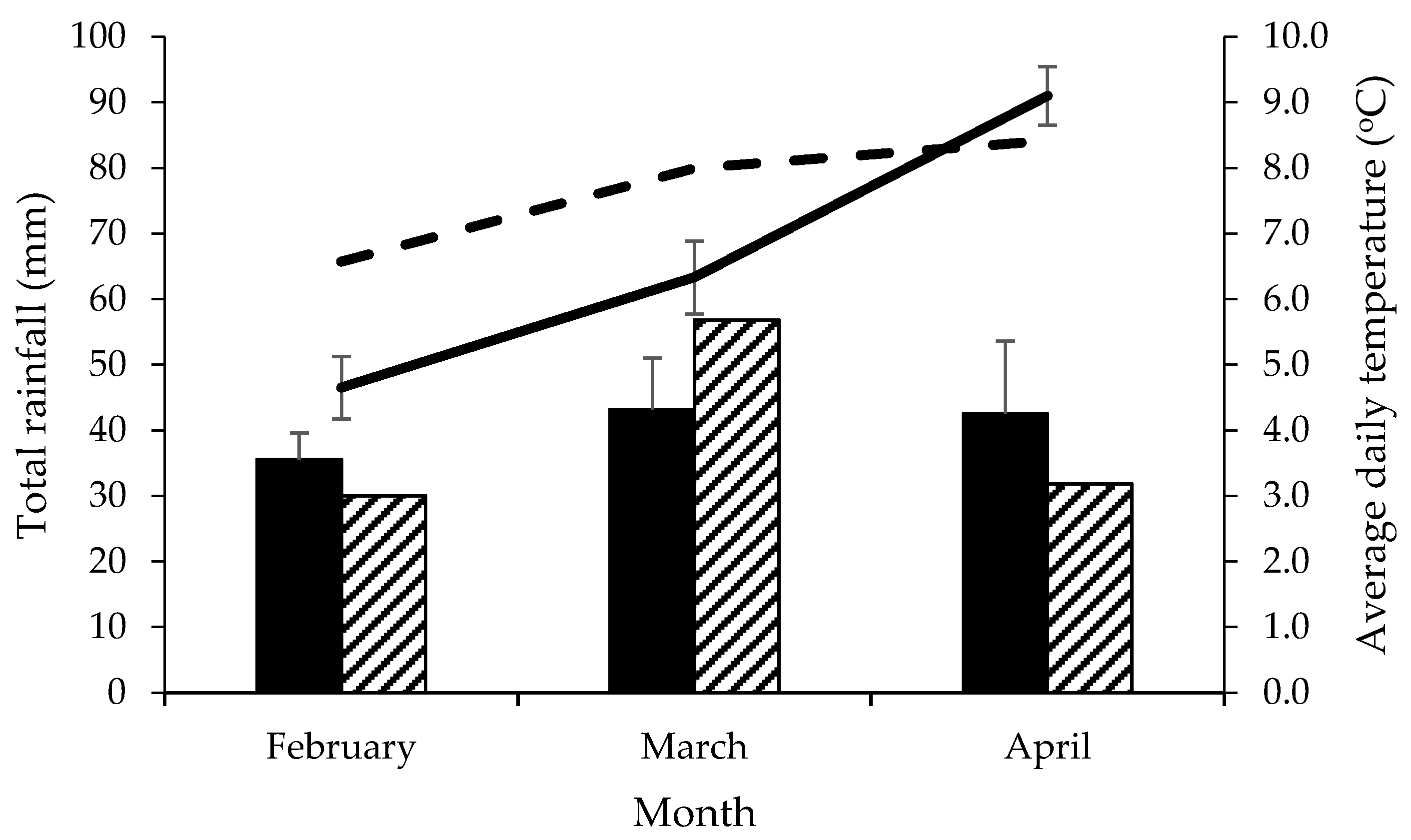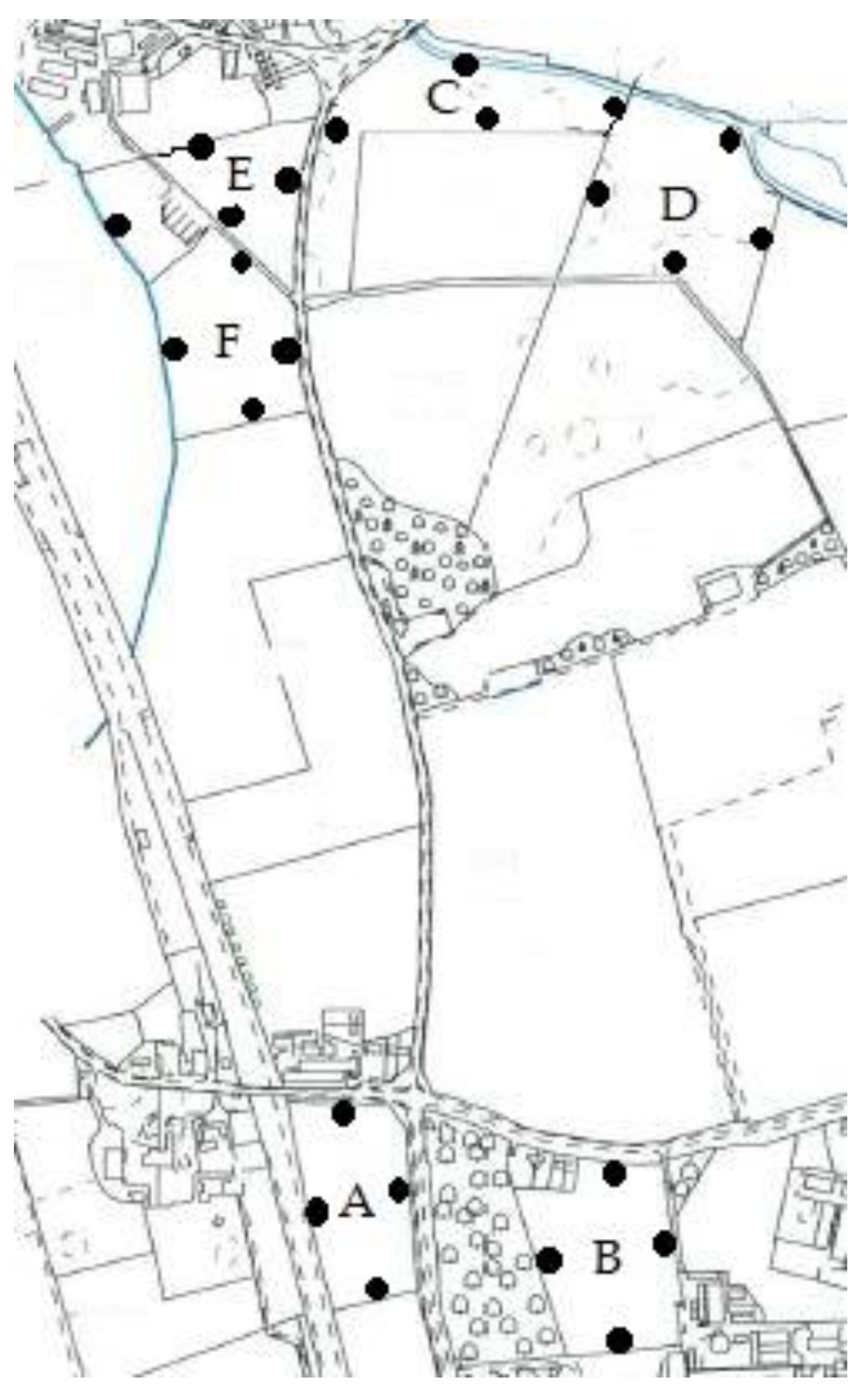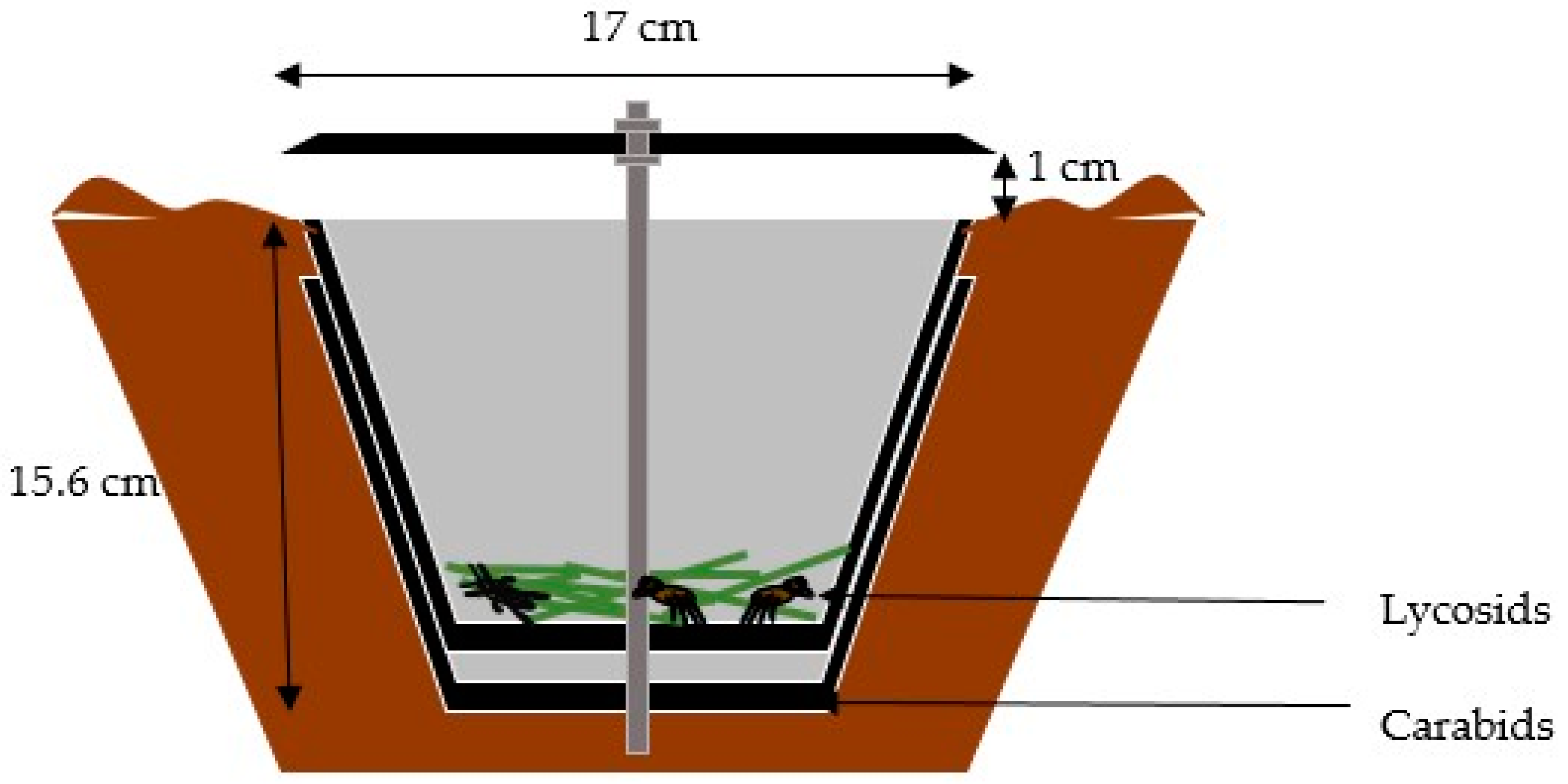Effect of Herbage Density, Height and Age on Nutrient and Invertebrate Generalist Predator Abundance in Permanent and Temporary Pastures
Abstract
1. Introduction
2. Materials and Methods
2.1. Field Data
2.2. Herbage and Invertebrate Measurements
2.3. Statistical Analysis
3. Results
3.1. Variability Among Fields Studied
3.2. Effect of Sward Age
3.3. Effect of Herbage Height and Density
4. Discussion
5. Conclusions
Author Contributions
Funding
Acknowledgments
Conflicts of Interest
References
- Suttie, J.M.; Reynolds, S.G.; Batello, C. Grasslands of the World. Available online: http://www.fao.org/3/y8344e00.htm#Contents (accessed on 4 February 2020).
- Gibon, A. Managing grassland for production, the environment and the landscape: Challenges at the farm and the landscape level. Livest. Prod. Sci. 2005, 96, 11–31. [Google Scholar] [CrossRef]
- Dillon, P. Achieving high dry-matter intake from pasture with grazing dairy cows. In Fresh Herbage for Dairy Cattle; Springer: Dordrecht, The Netherlands, 2006; pp. 1–26. [Google Scholar] [CrossRef]
- Defra. Annual Statistics About Agriculture in the United Kingdom to 2018. Available online: https://www.gov.uk/government/statistics/agriculture-in-the-united-kingdom-2018 (accessed on 4 February 2020).
- Frame, J.; Laidlaw, A.S. Improved Grassland Management; The Crowood Press: Marlborough, UK, 2011. [Google Scholar]
- McDonald, P.; Edwards, R.A.; Greenhalgh, J.F.D.; Morgan, C.A.; Sinclair, L.A.; Wilkinson, R.G. Animal Nutrition, 5th ed.; Longman Press: Harlow, UK, 2011. [Google Scholar]
- Finch, H.J.S.; Samuel, A.M.; Lane, G.P.F. Lockhart and Wiseman’s Crop Husbandry Including Grassland, 8th ed.; Woodhead Publishing Limited: Cambridge, UK, 2002. [Google Scholar]
- Moorby, J.M.; Evans, R.T.; Scollan, N.D.; MacRae, J.C.; Theodorou, M.K. Increased concentration of water-soluble carbohydrate in perennial ryegrass (Lolium perenne L.). Evaluation in dairy cows in early lactation. Grass Forage Sci. 2006, 61, 52–59. [Google Scholar] [CrossRef]
- Hopkins, A.; Wilkins, R.J. Temperate grassland: Key developments in the last century and future perspectives. J. Agric. Sci. 2006, 144, 503–523. [Google Scholar] [CrossRef]
- Pullanagari, R.R.; Yule, I.J.; Tuohy, M.P.; Hedley, M.J.; Dynes, R.A.; King, W.M. In-field hyperspectral proximal sensing for estimating quality parameters of mixed pasture. Precis. Agric. 2012, 13, 351–369. [Google Scholar] [CrossRef]
- Pullanagari, R.R.; Kereszturi, G.; Yule, I.J. Integrating Airborne Hyperspectral, Topographic, and Soil Data for Estimating Pasture Quality Using Recursive Feature Elimination with Random Forest Regression. Remote Sens. 2018, 10, 1117. [Google Scholar] [CrossRef]
- Bell, M.J.; Mereu, L.; Davis, J. The Use of Mobile Near-Infrared Spectroscopy for Real-Time Pasture Management. Front. Sustain. Food Syst. 2018, 2. [Google Scholar] [CrossRef]
- Dale, A.J.; Gordon, A.W.; Archer, J.; Ferris, C.P. Impact of sampling and storage technique, and duration of storage, on the composition of fresh grass when analysed using near-infrared reflectance spectroscopy. Grass Forage Sci. 2016, 72, 614–625. [Google Scholar] [CrossRef]
- Rusch, A.; Birkhofer, K.; Bommarco, R.; Smith, H.G.; Ekbom, B. Management intensity at field and landscape levels affects the structure of generalist predator communities. Oecologia 2014, 175, 971–983. [Google Scholar] [CrossRef]
- Holland, J.M.; Bianchi, F.J.; Entling, M.H.; Moonen, A.C.; Smith, B.M.; Jeanneret, P. Structure, function and management of semi-natural habitats for conservation biological control: A review of European studies. Pest Manag. Sci. 2016, 72, 1638–1651. [Google Scholar] [CrossRef]
- Bell, J.R.; Wheater, C.P.; Cullen, W.R. The implications of grassland and heathland management for the conservation of spider communities: A review. J. Zool. 2001, 255, 377–387. [Google Scholar] [CrossRef]
- Thomas, C.F.G.; Blackshaw, R.P.; Hutchings, L.; Woolley, C.; Goodacre, S.; Hewitt, G.M.; Ibrahim, K.; Brooks, S.P.; Harrington, R. Modelling life-history/dispersal-strategy interactions to predict and manage linyphiid spider diversity in agricultural landscapes. IOBC WPRS Bull. 2003, 26, 167–172. [Google Scholar] [CrossRef]
- Batáry, O.; Báldi, A.; Samu, F.; Szűts, T.; Erdős, S. Are spiders reacting to local or landscape scale effects in Hungarian pastures? Biol. Conserv. 2008, 141, 2062–2070. [Google Scholar] [CrossRef]
- Begg, G.S.; Cook, S.M.; Dye, R.; Ferrante, M.; Franck, P.; Lavigne, C. A functional overview of conservation biological control. Crop Prot. 2017, 97, 145–158. [Google Scholar] [CrossRef]
- Michalko, R.; Pekár, S.; Dul’a, M.; Entling, M.H. Global patterns in the biocontrol efficacy of spiders: A meta-analysis. Global Ecol. Biogeogr. 2019. [Google Scholar] [CrossRef]
- Roberts, M.J. Collins field guide. In Spiders of Britain and Northern Europe; HarperCollins: London, UK, 1995. [Google Scholar]
- Bee, L.; Oxford, G.; Smith, H. Britain’s Spiders: A Field Guide; Princeton University Press: Woodstock, UK, 2017. [Google Scholar]
- Chinery, M. Collins field guide. In Insects of Britain and Northern Europe; HarperCollins: London, UK, 1993. [Google Scholar]
- Wilkins, P.W.; Humphreys, M.O. Progress in breeding perennial forage grasses for temperate agriculture. J. Agric. Sci. 2003, 140, 129–150. [Google Scholar] [CrossRef]
- Miller, L.A.; Moorby, J.M.; Davies, D.R.; Humphreys, M.O.; Scollan, N.D.; MacRae, J.C.; Theodorou, M.K. Increased concentration of water-soluble carbohydrate in perennial ryegrass (Lolium perenne L.): Milk production from late-lactation dairy cows. Grass Forage Sci. 2001, 56, 383–394. [Google Scholar] [CrossRef]
- Colmenero, J.O.; Broderick, G.A. Effect of dietary crude protein concentration on milk production and nitrogen utilization in lactating dairy cows. J. Dairy Sci. 2006, 89, 1704–1712. [Google Scholar] [CrossRef]
- Wilkinson, J.M.; Allen, J.D.; Tunnicliffe, R.; Smith, M.; Garnsworthy, P.C. Variation in composition of pre-grazed pasture herbage in the United Kingdom, 2006–2012. Anim. Feed Sci. Technol. 2014, 196, 139–144. [Google Scholar] [CrossRef]
- Binnie, R.C.; Kilpatrick, D.J.; Chestnutt, D.M.B. Effect of altering the length of the regrowth interval in early, mid and late season on the productivity of grass swards. J. Agric. Sci. 1997, 128, 303–309. [Google Scholar] [CrossRef]
- Crosse, M.; O’Donovan, M.; Boland, T.M.; Delaby, L.; Ganche, E.; Kennedy, E. Using post-grazing sward height to impose dietary restrictions of varying duration in early lactation: Its effects on spring-calving dairy cow production. Animal 2015, 9, 592–603. [Google Scholar] [CrossRef]
- Curran, J.; Delaby, L.; Kennedy, E.; Murphy, J.P.; Boland, T.M.; O’Donovan, M. Sward characteristics, grass dry matter intake and milk production performance are affected by pre-grazing herbage mass and pasture allowance. Livest. Sci. 2010, 127, 144–154. [Google Scholar] [CrossRef]
- Legay, N.; Lavorel, S.; Baxendale, C.; Krainer, U.; Bahn, M.; Binet, M.-N.; Cantarel, A.A.M.; Colace, M.-P.; Foulquier, A.; Kastl, E.-M.; et al. Influence of plant traits, soil microbial properties, and abiotic parameters on nitrogen turnover of grassland ecosystems. Ecosphere 2016, 7, 1–17. [Google Scholar] [CrossRef]
- Shalloo, L.; Creighton, P.; O’Donovan, M. The economics of reseeding on a dairy farm. Irish J. Agric. Food Res. 2011, 50, 113–122. Available online: https://t-stor.teagasc.ie/handle/11019/55 (accessed on 1 February 2020).
- McLenaghen, R.D.; Malcolm, B.J.; Cameron, K.C.; Di, H.J.; McLaren, R.G. Improvement of degraded soil physical conditions following the establishment of permanent pasture. N. Z. J. Agric. Res. 2017, 60, 287–297. [Google Scholar] [CrossRef]
- McNally, S.R.; Beare, M.H.; Curtin, D.; Meenken, E.D.; Kelliher, F.M.; Calvelo Pereira, R.; Shen, Q.; Baldock, J. Soil carbon sequestration potential of permanent pasture and continuous cropping soils in New Zealand. Glob. Chang. Biol. 2017, 23, 4544–4555. [Google Scholar] [CrossRef]
- Petillon, J.; Georges, A.; Canard, A.; Ysnel, F. Impact of cutting and sheep grazing on ground-active spiders and carabids in intertidal salt marshes (Western France). Anim. Biodivers. Conserv. 2007, 30, 201–209. [Google Scholar]
- Wolz, M.; Klockmann, M.; Schmitz, T.; Pekár, S.; Bonte, D.; Uhl, G. Dispersal and life-history traits in a spider with rapid range expansion. Mov. Ecol. 2020, 8, 2. [Google Scholar] [CrossRef]
- Gallé, R.; Samu, F.; Zsigmond, A.; Gallé-Szpisjak, N.; Urák, I. Even the smallest habitat patch matters: On the fauna of peat bogs. J. Insect. Conserv. 2019, 23, 699–705. [Google Scholar] [CrossRef]
- Alderweireldt, M.; Maelfait, J.-P. Life cycle, habitat choice and distribution of Pardosa amentata (Clerck, 1757) in Belgium (Araneae, Lycosidae). Bull. Sociètè Sci. Bretagne Comptes Rendus Xëme Colloq. Eur. Arachnol. 1988, 59, 7–15. [Google Scholar]
- Loreau, M. Annual activity and life cycle of carabid beetles in two forest communities. Ecography 1985, 8, 228–235. [Google Scholar] [CrossRef]
- Woodcock, B.A. Pitfall trapping in ecological studies. In Insect Sampling in Forest Ecosystems; Leather, S., Ed.; Blackwell Science Ltd.: Oxford, UK, 2005; pp. 37–58. [Google Scholar]



| Field | Soil Type | Pasture Type | Predominant Pasture Species | Use | Nutrient Applications | Average Soil Dry Matter (min–max) g/kg | Average Soil Available Nitrogen (min–max) kg/ha |
|---|---|---|---|---|---|---|---|
| A | Sandy loam | Temporary ley (2 years old) | Perennial ryegrass and white clover | To be harvested for silage | Inorganic fertilizer (70 kg of ammonium nitrate of 34.5% N: 0% P:0% K) plus 1 × 30 m3/ha (0.7 kg N/m3) of dirty water | 823 (806–847) | 39.9 (18.5–82.1) |
| B | Sandy loam | Perennial ryegrass | Sheep grazing | 815 (800–840) | 30.5 (12.9–60.3) | ||
| C | Sandy loam | Permanent and never cultivated | Perennial ryegrass, timothy, Yorkshire fog, cocksfoot, common bent, meadow grass | Sheep grazing | Inorganic fertilizer (70 kg of ammonium nitrate of 34.5% N: 0% P:0% K) | 763 (729–808) | 35.8 (16.7–56.6) |
| D | Sandy loam | 802 (773–851) | 28.0 (9.4–51.4) | ||||
| E | Sandy loam | Temporary ley (1 year old) | Perennial ryegrass, White clover | To be harvested for silage | Inorganic fertilizer (70 kg of ammonium nitrate of 34.5% N: 0% P:0% K) plus 1 × 30 m3/ha (0.7 kg N/m3) of dirty water | 820 (798–846) | 22.9 (11.0–42.7) |
| F | Sandy loam | 845 (827–875) | 29.1 (13.5–58.6) |
| Variable | Units | Mean (s.d) | Range | Coefficient of Variation (%) |
|---|---|---|---|---|
| Herbage production | ||||
| Height | cm | 8.6 (4.3) | 3.1–19.9 | 50 |
| Fresh weight | kg FW/ha | 7613 (4021) | 1861–18494 | 53 |
| Dry matter | kg DM/ha | 1370 (718) | 462–3253 | 52 |
| Fresh density | kg FW/ha/cm | 867 (205) | 412–1401 | 24 |
| Dry density | kg DM/ha/cm | 173 (43) | 106–296 | 25 |
| Herbage nutrients | ||||
| Dry matter | g/kg | 204 (34) | 160–301 | 21 |
| Crude protein | g/kg DM | 129 (6) | 117–141 | 5 |
| Neutral detergent fibre | g/kg DM | 410 (26) | 373–483 | 6 |
| Acid detergent fibre | g/kg DM | 219 (11) | 187–239 | 5 |
| Sugars | g/kg DM | 139 (13) | 98–158 | 9 |
| Ash | g/kg DM | 85 (5) | 71–95 | 6 |
| Digestible organic matter | g/kg DM | 706 (12) | 672–722 | 2 |
| Oil | g/kg DM | 21 (2) | 17–24 | 10 |
| Metabolisable energy | MJ/kg DM | 10.4 (0.3) | 9.6–10.8 | 3 |
| Invertebrate numbers | ||||
| Lycosids | No. per pot | 1.7 (1.1) | 0–5.23 | 65 |
| Carabids | No. per pot | 2.0 (1.4) | 0–7.3 | 70 |
| Age of Sward2 | |||||||
|---|---|---|---|---|---|---|---|
| Variable | Units | 1 Year | 2 Years | Permanent | SED | F-Statistic | P Value |
| Herbage production | |||||||
| Height | cm | 11.7a | 7.6b | 8.1b | 0.7 | 9.2 | <0.01 |
| Fresh weight | kg FW/ha | 9859 | 6005 | 6974 | 1090 | 6.8 | 0.077 |
| Dry matter | kg DM/ha | 1743 | 1118 | 1558 | 162 | 7.9 | 0.064 |
| Fresh density | kg FW/ha/cm | 867 | 882 | 871 | 39.6 | 0.1 | 0.919 |
| Dry density | kg DM/ha/cm | 152a | 157a | 196b | 9.8 | 8.8 | <0.01 |
| Herbage nutrients | |||||||
| Dry matter | g/kg | 173a | 196b | 244c | 7.5 | 41.3 | <0.001 |
| Crude protein | g/kg DM | 131a | 132a | 127b | 1.6 | 5.9 | <0.01 |
| NDF2 | g/kg DM | 391a | 404b | 423c | 4.8 | 18.2 | <0.001 |
| ADF2 | g/kg DM | 224 | 221 | 218 | 2.6 | 2.1 | 0.148 |
| Ash | g/kg DM | 86.2a | 87.4a | 83.2b | 1.4 | 12.7 | <0.001 |
| Oil | g/kg DM | 21.7a | 21.8a | 20.5b | 0.4 | 7.5 | <0.01 |
| Sugars | g/kg DM | 143ab | 147b | 140a | 2.8 | 6.2 | <0.01 |
| DOMD2 | g/kg DM | 712a | 702b | 706a | 2.4 | 5.5 | <0.05 |
| ME2 | MJ/kg DM | 10.6a | 10.5a | 10.3b | 0.05 | 10.5 | <0.001 |
| Invertebrate numbers | |||||||
| Lycosids | No. per pot | 1.3 | 2.0 | 1.9 | 0.4 | 2.8 | 0.082 |
| Carabids | No. per pot | 0.9a | 1.6b | 2.8c | 0.4 | 7.6 | <0.01 |
| Effect (s.e) d.f. = 1 | F-Statistic | P Value | ||||||||
|---|---|---|---|---|---|---|---|---|---|---|
| Variable | Units | Density | Height | Density × Height | Density | Height | Density × Height | Density | Height | Density × Height |
| Herbage nutrients | ||||||||||
| Dry matter | g/kg | 0.14 (0.08) | −0.09 (1.0) | −0.10 (0.02) | 79.8 | 1.4 | 1.8 | <0.001 | 0.250 | 0.189 |
| Crude protein | g/kg DM | −0.008 (0.018) | 0.38 (0.2) | 0.004 (0.005) | 8.2 | 3.8 | 0.1 | <0.01 | 0.059 | 0.815 |
| NDF | g/kg DM | 0.02 (0.06) | 0.06 (0.6) | −0.04 (0.02) | 19.2 | 3.3 | 0 | <0.001 | 0.078 | 0.954 |
| ADF | g/kg DM | 0.05 (0.03) | 1.05 (0.3) | −0.01 (0.01) | 2.8 | 24.6 | 15.4 | 0.107 | <0.001 | <0.001 |
| Ash | g/kg DM | −0.02 (0.01) | 0.04 (0.2) | 0.01 (0.003) | 24.6 | 3.9 | 0.7 | <0.001 | 0.058 | 0.426 |
| Oil | g/kg DM | 0.0004 (0.004) | 0.07 (0.05) | 0.002 (0.001) | 6.6 | 4.7 | 0.04 | <0.05 | <0.05 | 0.840 |
| Sugars | g/kg DM | 0.07 (0.03) | 0.70 (0.4) | 0.03 (0.01) | 1.5 | 1.1 | 12.7 | 0.231 | 0.299 | <0.01 |
| DOMD | g/kg DM | −0.002 (0.02) | −0.49 (0.30) | 0.02 (0.01) | 0.3 | 0.1 | 4.9 | 0.574 | 0.716 | <0.05 |
| ME | MJ/kg DM | 0.0005 (0.001) | 0.03 (0.01) | 0.0002 (0.0002) | 11.9 | 64.8 | 0.1 | <0.01 | <0.001 | 0.772 |
| Invertebrate numbers | ||||||||||
| Lycosids | No. per pot | 0.01 (0.004) | 0.10 (0.03) | 0.0002 (0.001) | 11.3 | 7.7 | 1.1 | <0.01 | <0.05 | 0.305 |
| Carabids | No. per pot | −0.001 (0.005) | 0.001 (0.04) | −0.002 (0.001) | 4.1 | 0 | 0 | 0.052 | 0.972 | 0.965 |
© 2020 by the authors. Licensee MDPI, Basel, Switzerland. This article is an open access article distributed under the terms and conditions of the Creative Commons Attribution (CC BY) license (http://creativecommons.org/licenses/by/4.0/).
Share and Cite
Toupet, R.; Gibbons, A.T.; Goodacre, S.L.; Bell, M.J. Effect of Herbage Density, Height and Age on Nutrient and Invertebrate Generalist Predator Abundance in Permanent and Temporary Pastures. Land 2020, 9, 164. https://doi.org/10.3390/land9050164
Toupet R, Gibbons AT, Goodacre SL, Bell MJ. Effect of Herbage Density, Height and Age on Nutrient and Invertebrate Generalist Predator Abundance in Permanent and Temporary Pastures. Land. 2020; 9(5):164. https://doi.org/10.3390/land9050164
Chicago/Turabian StyleToupet, Rémi, Alastair T. Gibbons, Sara L. Goodacre, and Matt J. Bell. 2020. "Effect of Herbage Density, Height and Age on Nutrient and Invertebrate Generalist Predator Abundance in Permanent and Temporary Pastures" Land 9, no. 5: 164. https://doi.org/10.3390/land9050164
APA StyleToupet, R., Gibbons, A. T., Goodacre, S. L., & Bell, M. J. (2020). Effect of Herbage Density, Height and Age on Nutrient and Invertebrate Generalist Predator Abundance in Permanent and Temporary Pastures. Land, 9(5), 164. https://doi.org/10.3390/land9050164






